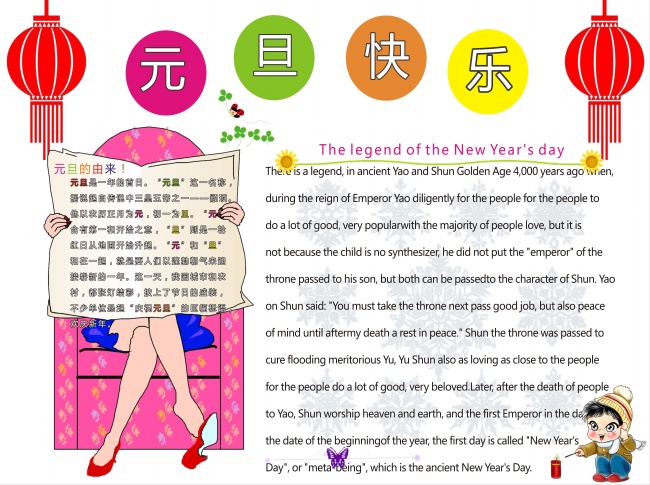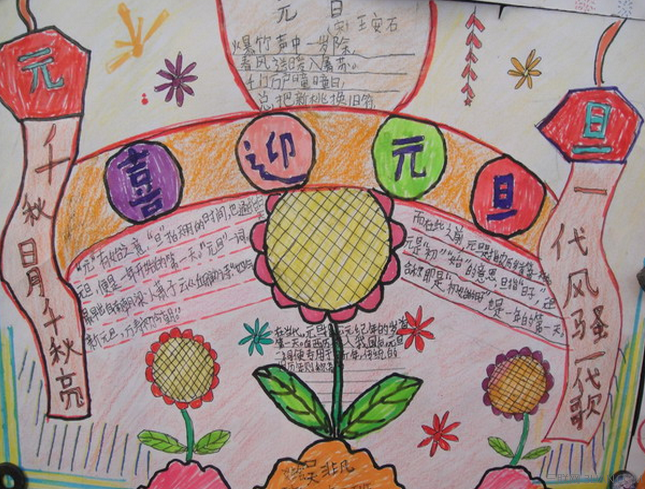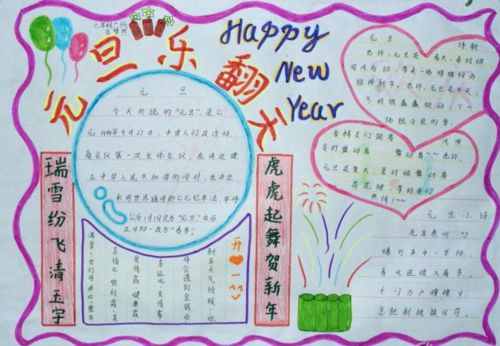元,谓“首”;旦,谓“日”;“元旦”意即“首日”。以下是出国留学网小编为您整理庆元旦手抄报资料,供您参考,希望对你有所帮助,更多详细内容请点击出国留学网查看。
庆元旦手抄报资料1

庆元旦手抄报资料2

庆元旦手抄报资料3

庆元旦手抄报资料4
传说在4000多年前远古的 尧舜盛世之时,尧天子在位时勤政于民为百姓办了很多好事,很受广大百姓爱戴,但因其子无才不太成器,他没把“天子”的皇位传给自己的儿子,而是传给了品德才能兼备的 舜。尧对舜说:“你今后一定要把帝位传交好,待我死后也可安心瞑目了。”后来舜把帝位传给了治洪水有功的禹,禹亦像舜那样亲民爱民为百姓做了很多好事,都十分受人爱戴。后来人们把尧死后,舜帝祭祀天地和先帝尧的那一天,当作一年的开始之日,把正月初一称为“元旦”,或“元正”,这就是古代的元旦。
历代皇朝都在元旦举行庆贺典仪祈祀等活动,如祭诸神祭先祖,写门对挂春联,书写福字、舞龙灯,民间也逐渐形成祭神佛、祭祖先、贴春联、放鞭炮、守岁、吃团圆饭以及众多的“社火”等娱乐欢庆活动。晋代诗人辛兰曾有《 元正》诗:“元正启令节,嘉庆肇自兹。咸奏万年觞,小大同悦熙。”记述元旦庆贺情景。
庆元旦手抄报资料5
元旦,据说起于 三皇五帝之一的 颛顼,距今已有4000多年的历史。 “元旦”一词最早出现于《 晋书》:“颛帝以孟夏正月为元,其实正朔元旦之春。 ”
南北朝时,南朝文史学家 萧子云的《 介雅》诗中有“四季新元旦,万寿初春朝”的记载。宋代吴自牧《 梦粱录》中有关于:“正月朔日,谓之元旦,俗呼为新年。一岁节序,此为之首。”的记载。
汉代 崔瑗《三子钗铭》中叫“元正”、晋代 庾阐《扬都赋》一赋中称作“ 元辰”、 北齐时的《元会大享歌皇夏辞》一辞中呼为“ 元春”、 唐德宗- 李适《元日退朝观军仗归营》一诗中谓之“ 元朔”。
中国元旦历来指的是 夏历(农历、阴历)正月初一。正月初一的计算方法,在汉武帝时期以前也是很不统一的。因此,历代的元旦月、日也并不一致。 夏朝的夏历以孟喜月( 元月)为正月,商朝的殷历以腊月(十二月)为正月,周朝的周历以冬月(十一月)为正月。 秦始皇统一中国后,又以阳春月(十月)为正月,即十月初一为元旦。
从 汉武帝起,规定孟喜月(元月)为正月,把孟喜月的第一天(夏历的正月初一)称为元旦,一直沿用到清朝末年。
公元1911年,孙中山领导的 辛亥革命推翻了满清的统治,建立了中华民国。各省都督代表在南京开会决定使用公历,把农历的1月1日叫做“春节”,把公历的1月1日称为“元旦”,不过当时并没有正式公布。
为了“行夏正,所以顺农时,从西历,所以便统计”,民国元年决定使用公历(实际使用是1912年),并规定 阳历1月1日为“新年”,但并不称为“元旦”。
1949年9月27日,第一届 中国人民政治协商会议,在决定建立中华人民共和国的同时,也决定采用世界通用的公元纪年法,即我们所说的阳历。元旦,指西元纪年的岁首第一天。
为区别农历和阳历两个新年,又鉴于农历二十四节气中的 “立春”恰在农历新年的前后,因此便把农历一月一日改称为“春节”,阳历1月1日定为新年的开始――“元旦”,并列入法定假日,成为全国人民的节日。
专家:“元旦”一词系中国“土产” 已经沿用4000多年。
每年1月1日,标志着新一年的到来,人们习惯将这一天称为“元旦”,俗称“阳历年”。
天文专家表示,“元旦”一词系中国“土产”,在中国农历中已沿用4000多年,但现行公历“元旦”为1949年所定,随着2016年的到来,它只有“67岁”。
庆元旦手抄报资料6
元旦 New Year's Day
元旦的英文介绍
New Year's Day is the first day of the lunar calendar. it is the day when the earth has circled the sun for one round and is beginning another circling. it represents a new beginning when people send off the old days and welcome the new ones. as the first day of the year, yuandan has been considered to be the most important festival since the ancient times.
元旦是农历的第一天。这是一天,当地球绕着太阳转一圈,正在开始另一个循环。当人们送走旧的日子,并欢迎新的朋友的时候,它代表了一个新的开始。作为一年的第一天,元旦已被认为是自古以来最重要的节日。
customs
1.kaisui(beginning of the year): according to the chinese traditional custom, starting from haishi(9p.m. to 11p.m.)of the last evening of the twelfth lunar month, each family must prepare offering s to deities at the altar. at the same time, they too prepare food for the new year day: the whole family will then stay awake together to attend to the year(called shou sui). after haishi, zishi(11p.m. to 1a.m.)will come, and this is the arrival of new year(yuandan). at this moment, people begin the celebration with fireworks. vegetarian and sweet foods will then be placed are the altar for offerings, and incense be burned to welcome the deities. in the ancient times, it was believed that haishi connected the two years and thus was called kaisui.
At the same night, some families will follow the instruction in tongshu and place preparing altar in the direction of the "fortune deity" during the "fortune time" to receive the deity. if the direction of the "fortune deity" is at the "ill position", people will choose to receive "happy deity" or "noble deity" instead.
习俗
开岁(一年的开始):根据中国传统习俗,从亥时(21点到23点)的阴历第十二个月的最后一个晚上,每个家庭必须准备提供的s到神的祭坛。同时,他们也准备了新的一年的食物:整个家庭,然后保持清醒,一起参加一年(称为守岁)。在亥时,子时(23:00-1:00.)会来的,这是新的一年的到来(元旦)。在这一刻,人们开始用烟火庆祝。素食和甜食,然后被放置在祭坛,和香被烧毁欢迎神。在古代,人们认为亥时连接两年,因此被称为“开岁”。
在同一天晚上,一些家庭将按照在统和地方在“幸运神”在“财富时间”得到神的祭坛方向准备指令。如果“财富之神”的方向是“不适的位置”,人们会选择接受“快乐之神”或“高贵的神”。
2. There is an apparent difference in the custom of food taking on yuandan between the chinese in the northern and southern regions. the northern chinese has the habit of taking jiao zi(dumpling made of flour with vegetable and meat wrapped inside). some people may put a sweet or a coin inside jiao zi, hoping to have a sweet year after tasting the sweet and a wealthy year after tasting the coin. on the other hand, the southern chinese have the taboo for killing on yuandan. therefore, they do not take meat in tee morning of yuandan, so as to avoid bloodshed or mutual slaughter. in order to evade misfortune, they have the first meal of this day without meat. instead, they take vegetarian food for the sake of virtue.
在以北部和南部地区之间的中国的元旦食物习惯明显不同。北方人有取饺子的习惯(饺子是用面粉做的,里面有蔬菜和肉包)。有些人可能把一个甜的或一个硬币内的饺子,希望有一个甜蜜的一年后品尝的甜蜜和一个富裕的一年后,品尝硬币。另一方面,中国南方有就元旦杀害禁忌。因此,他们不参加的元旦早上发球肉类,以避免流血或互相残杀。为了逃避不幸,他们在这一天的第一顿饭没有肉。相反,他们以素食为美德。
3. What is special during the new year is that parents or elders will distribute red packets(ang pao or ya sui qian)to the children. people in the ancient times were more particular in giving away the red packets: the distribution took place on the eve of new year so that the kids could suppress the past year and enter the new year. ya sui has the meaning of overcoming the unpredictable future. representing the wishes for the healthy psychological growth of the children, ya sui qian symbolises the elders' hope to see their children overcome all the unpredictable elements brought by the "year".
新的一年里有什么特殊的是,父母或长辈会把红色的包(和“包”和“你的钱”)分发给孩子们。远古时代的人们更特别地在赠送红包:新的一年的除夕之夜的分布,使孩子们能压制过去的一年,进入新的一年。“雅”的意思是克服不可预知的未来。代表对健康儿童心理成长的愿望,压岁钱象征长老希望看到自己的孩子克服各种不可预知的因素所带来的“年”。
小编精心推荐
元旦节手抄报 | 迎新年手抄报 | 元旦小报 | 元旦黑板报 | 元旦资料
小编精心推荐